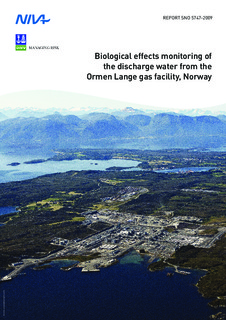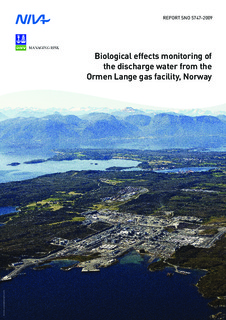| dc.contributor.author | Brooks, S. | nb_NO |
| dc.contributor.author | Harman, C. | nb_NO |
| dc.contributor.other | Brooks, S. - Project manager | nb_NO |
| dc.coverage.spatial | | nb_NO |
| dc.date.accessioned | 2014-08-01T10:53:01Z | |
| dc.date.available | 2014-08-01T10:53:01Z | |
| dc.date.issued | 2009 | nb_NO |
| dc.identifier | 5747 | nb_NO |
| dc.identifier.isbn | 978-82-577-5782-2 | nb_NO |
| dc.identifier.issn | 1894-7948 | nb_NO |
| dc.identifier.uri | http://hdl.handle.net/11250/214402 | |
| dc.description.abstract | The mussel, Mytilus edulis has been used to assess the biological effects of produced water (PW) discharged from the Ormen Lange gas processing plant on the West coast of Norway. An integrated monitoring approach was applied, using a combination of sensitive health index parameters in the mussel including lysosomal membrane stability (LMS) and micronuclei (MN) formation in haemocytes of live mussels, cell type composition, lysosomal membrane stability and peroxisome proliferators in mussel digestive gland, and contaminant body burden concentrations in whole tissue homogenates. In addition, semipermeable membrane devices (SPMDs) were used to support the biological effects data. The biological and chemical endpoints were measured in mussels from three different exposure scenarios: 1) native mussels found on the shore in the vicinity of the produced water discharge point; 2) mussels placed in cages at known distances from the produced water discharge point; and 3) mussels exposed to known concentrations of produced water in a laboratory controlled flow-through dosing system. The results of the biological effects data and chemical analysis are presented. For the native shore mussels, good agreement between biological effects measurements was observed. Mussels located at sites closest to Ormen Lange showed clear stress responses indicative of poor health status, compared to the reference mussels. For the caged mussels, contradictory biological effects measurements were found, which were thought partly due to the overall poor health of the mussels used. Consequently no firm conclusions were drawn about the cage exposure. In the controlled laboratory exposure to PW, biological effects were found in mussels exposed to 0.01% PW and above compared to a control group. Overall, although some were anomalous, the results indicate that Ormen Lange PW may have detrimental effects on mussel health. | nb_NO |
| dc.description.sponsorship | Norske Shell, Det Norske Veritas v/ Tormod Glette | nb_NO |
| dc.publisher | Norsk institutt for vannforskning | nb_NO |
| dc.relation.ispartofseries | NIVA-rapport;5747 | nb_NO |
| dc.rights | Navngivelse-IkkeKommersiell-DelPåSammeVilkår 3.0 Norge | nb_NO |
| dc.rights.uri | http://creativecommons.org/licenses/by-nc-sa/3.0/no/ | nb_NO |
| dc.subject | økotoksikologi og risikovurderinger | nb_NO |
| dc.title | Biological effects monitoring of the discharge water from the Ormen Lange gas facility, Norway | nb_NO |
| dc.type | Research report | nb_NO |
| dc.rights.holder | Norsk institutt for vannforskning/Norwegian institute for water research | nb_NO |
| dc.subject.nsi | VDP::Matematikk og naturvitenskap: 400 | nb_NO |
| dc.source.pagenumber | 53 | nb_NO |
| dc.subject.keyword | blåskjell biomarkører | nb_NO |
| dc.subject.keyword | produsert vann | nb_NO |
| dc.subject.keyword | passive prøvetakere | nb_NO |
| dc.subject.keyword | miljøovervåkning | nb_NO |
| dc.subject.keyword | mussel biomarkers | nb_NO |
| dc.subject.keyword | produced water | nb_NO |
| dc.subject.keyword | passive samplers | nb_NO |
| dc.subject.keyword | environmental monitoring | nb_NO |
| dc.relation.project | O-28285 | nb_NO |


